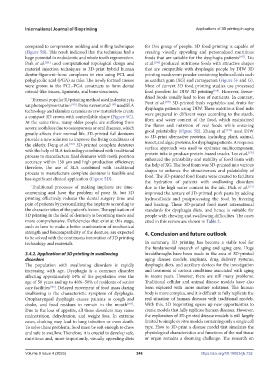Page 256 - IJB-9-4
P. 256
International Journal of Bioprinting Applications of 3D printing in aging
compared to compression molding and milling techniques for this group of people. 3D food printing is capable of
(Figure 5B). This result indicated that the technique had a creating visually appealing and personalized nutritious
huge potential in endodontic and whole tooth regeneration. foods that are suitable for the dysphagia patients [167] . Liu
Park et al. [161] used computational topological design and et al. [168] produced nutritious foods with attractive shapes
material injection techniques to 3D-print hybrid human that are compatible with dysphagia people by DIW 3D
dentin–ligament–bone complexes in vivo using PCL and printing mushroom powder containing hydrocolloids such
polyglycolic acid (PGA) as inks. The newly formed tissues as xanthan gum (XG) and carrageenan (Figure 5F and G).
were grown in the PCL–PGA constructs to form dental Most of current 3D food printing studies use processed
osteoid-like tissues, ligaments, and bone structures. food powders for DIW 3D printing [169] . However, freeze-
The most popular 3D printing method used in dentistry is dried foods usually lead to loss of nutrients. In contrast,
[170]
vat photopolymerization [162] . Dehurtevent et al. [163] used SLA Pant et al. 3D-printed fresh vegetables and fruits for
technology and alumina ceramics as raw materials to create dysphagia patients using DIW. These nutritious food inks
a compact 3D crown with controllable shape (Figure 5C). were prepared in different ways according to the starch,
At the same time, many older people are suffering from fiber, and water content of the food, which maintained
severe tooth loss due to osteoporosis or oral diseases, which the flavor and nutrition of real foods while ensuring
[171]
greatly affects their normal life. 3D-printed full dentures good printability (Figure 5E). Zhang et al. used DIW
provide a new solution to improve the living conditions of to 3D-print alternative proteins, including plant, animal,
the elderly. Deng et al. [164] 3D-printed complete dentures insect, and algae proteins, for dysphagia patients. A response
with the help of SLA technology combined with traditional surface approach was used to optimize multicomponent
[172]
process to manufacture final dentures with tooth position protein inks to produce protein-based snacks. Lee et al.
accuracy within 150 µm and high production efficiency; enhanced the printability and stability of food foam with
therefore, the use of SLA combined with traditional the help of XG. The food foam was 3D-printed into various
process to manufacture complete dentures is feasible and shapes to enhance the attractiveness and palatability of
has significant clinical application (Figure 5D). food. The 3D-printed food foams were created to facilitate
the hydration of patients with swallowing disorders
Traditional processes of making implants are time- due to the high water content in the ink. Dick et al. [173]
consuming and have the problem of poor fit, but 3D improved the texture of 3D-printed pork paste by adding
printing effectively reduces the dental surgery time and hydrocolloids and postprocessing the food by freezing
pain of patients by personalizing the implants according to and heating. These 3D-printed food meet international
the characteristics of the patient’s lesion. The application of standards for dysphagia diets, and hence is suitable for
3D printing in the field of dentistry is becoming more and people with chewing and swallowing difficulties. The cases
more comprehensive. Deficiencies that exist at this stage, cited in this review are shown in Table 2.
such as how to make a better combination of mechanical
strength and biocompatibility of the denture, are expected 4. Conclusion and future outlook
to be solved with the continuous innovation of 3D printing
technology and materials. In summary, 3D printing has become a viable tool for
the fundamental research of aging and aging care. Huge
3.4.2. Application of 3D printing in swallowing breakthroughs have been made in the area of 3D-printed
disorders aging disease models, implants, drug delivery systems,
The population with swallowing disorders is rapidly dysphagia diets, and auxiliary devices for the investigation
increasing with age. Dysphagia is a common disorder and treatment of various conditions associated with aging
affecting approximately 14% of the population over the in recent years. However, there are still many problems.
age of 50 years and up to 40%–50% of residents of senior Traditional cellular and animal disease models have also
care facilities [165] . Delayed movement of food mass during been explored with more mature solutions. The human
swallowing is the characteristic symptom of dysphagia. body is more complex, and it is difficult to fully replicate the
Oropharyngeal dysphagia causes patients to cough and real situation of human diseases with traditional models.
choke, and food residues to remain in the mouth [166] . With this, 3D bioprinting opens up new opportunities to
Due to the loss of appetite, all these disorders may cause create models that fully replicate human diseases. However,
malnutrition, dehydration, and weight loss. In extreme the exploration of 3D-printed disease models is still largely
cases, choking may lead to lung infection or even death. limited to simple in vitro models containing only a single cell
To solve these problems, food must be soft enough to chew type. How to 3D-print a disease model that simulates the
and safe to swallow. Therefore, it is crucial to develop safe, physiological characteristics and functions of the real tissue
nutritious and, more importantly, visually appealing diets or organ remains a daunting challenge. The research on
Volume 9 Issue 4 (2023) 248 https://doi.org/10.18063/ijb.732

